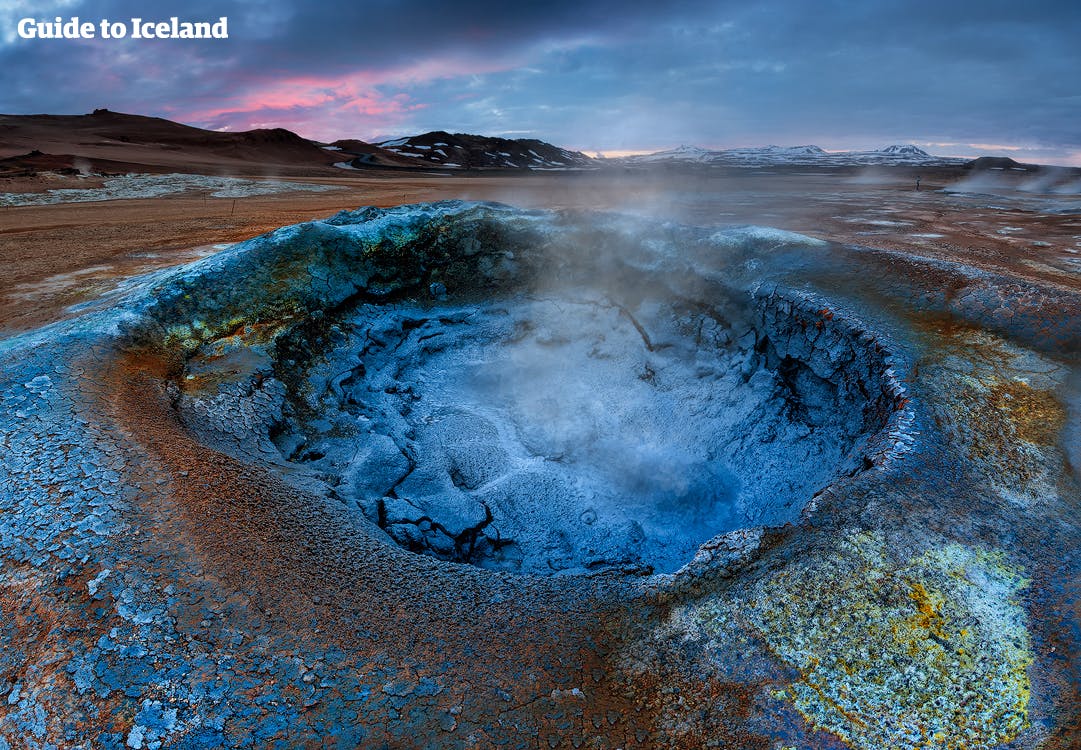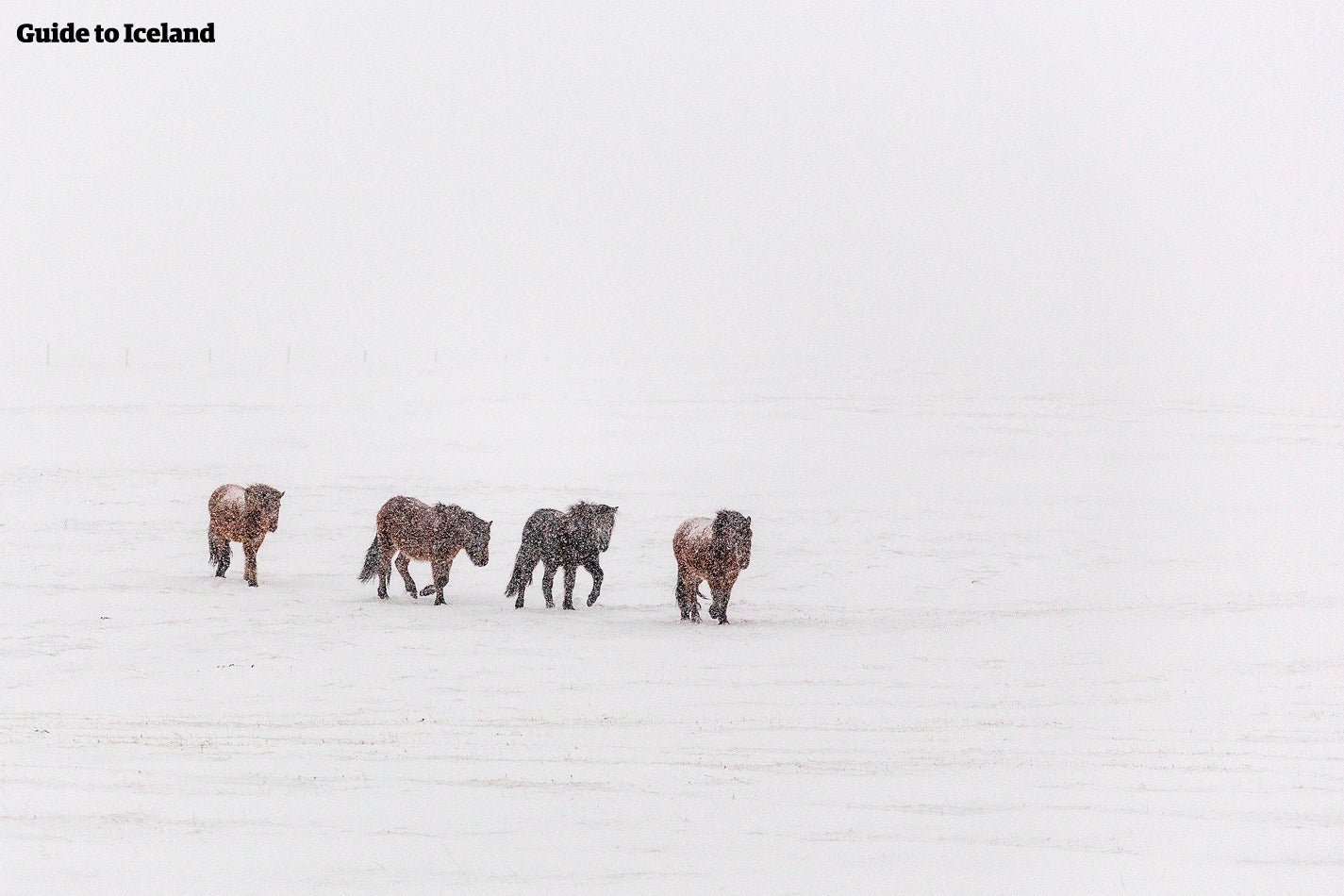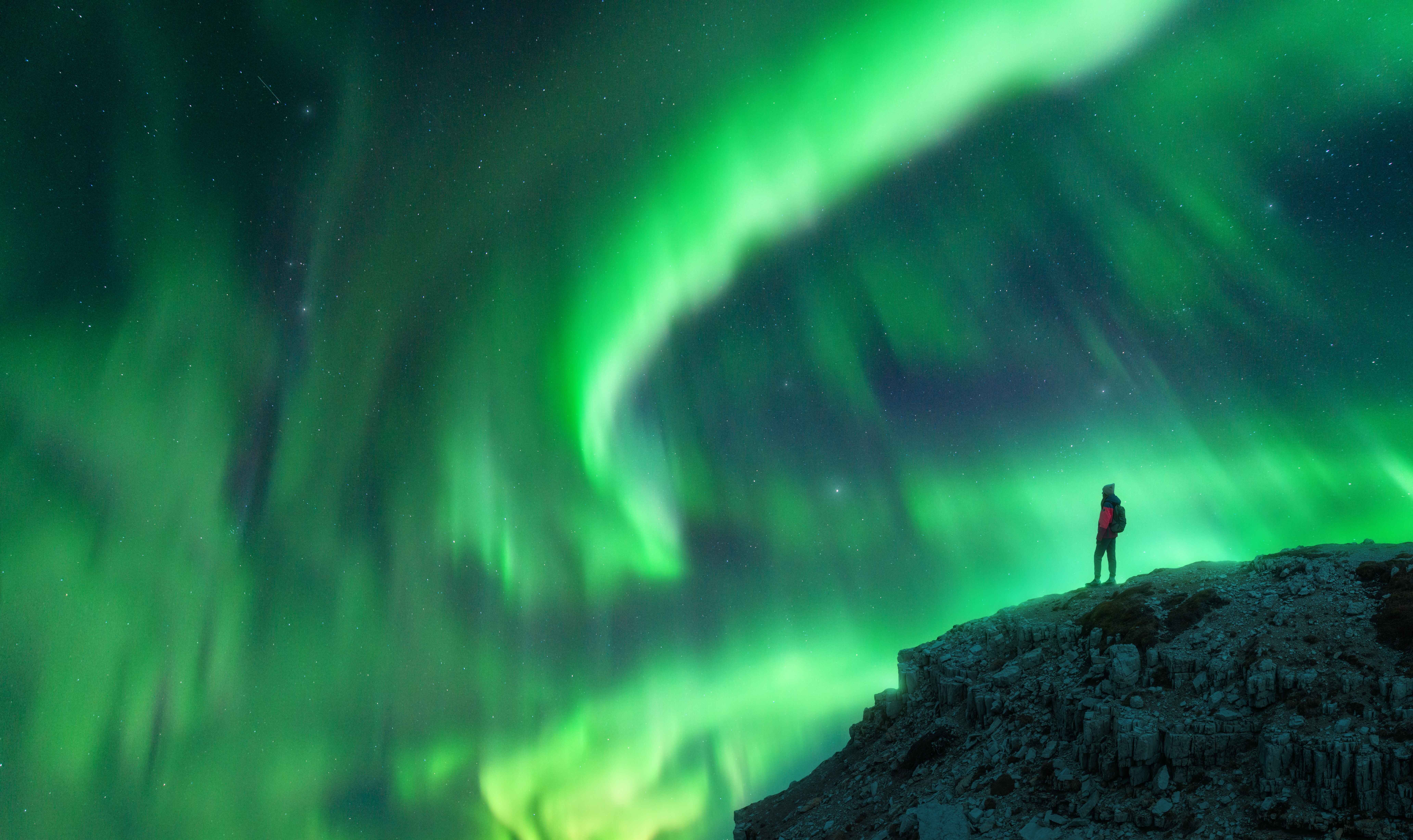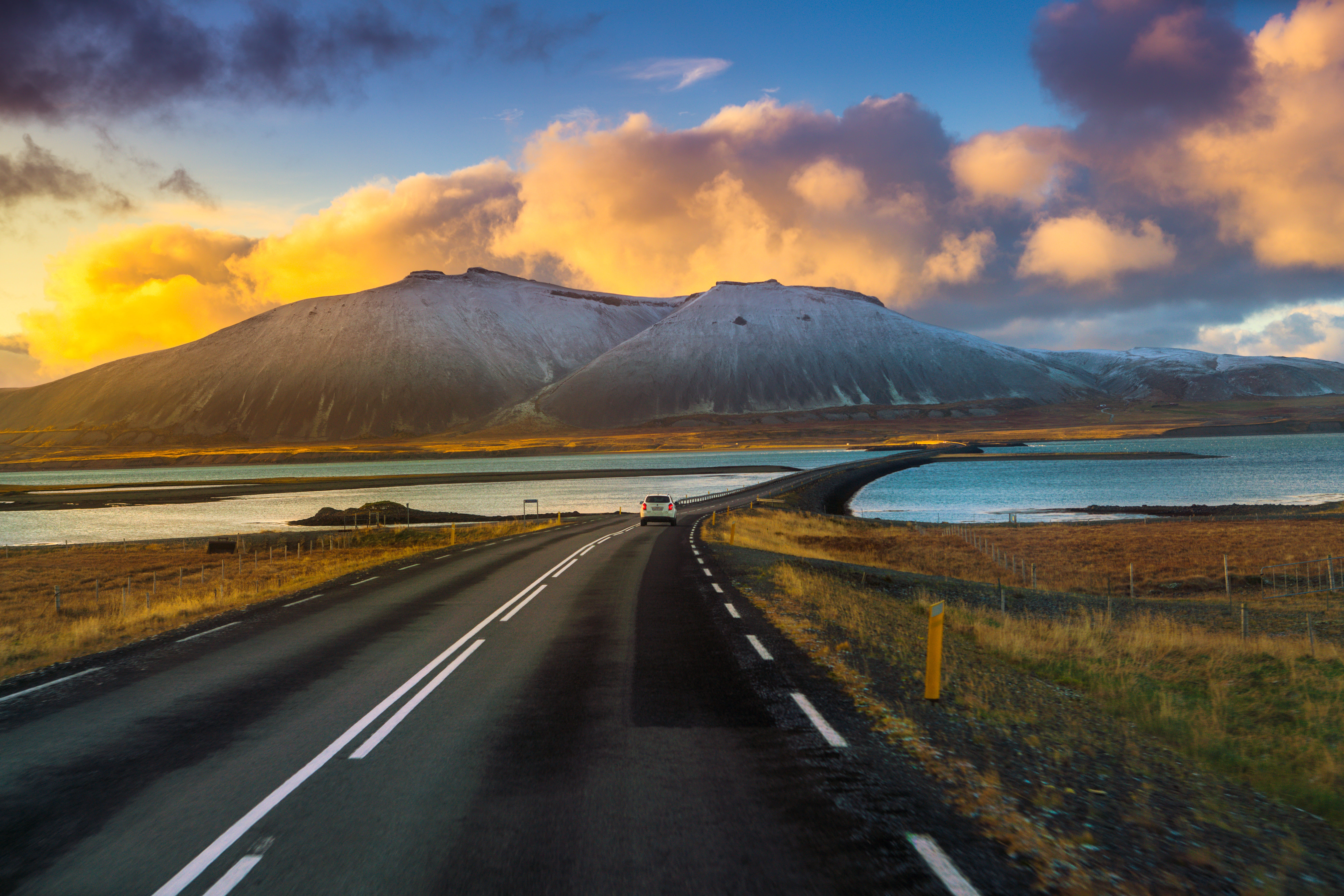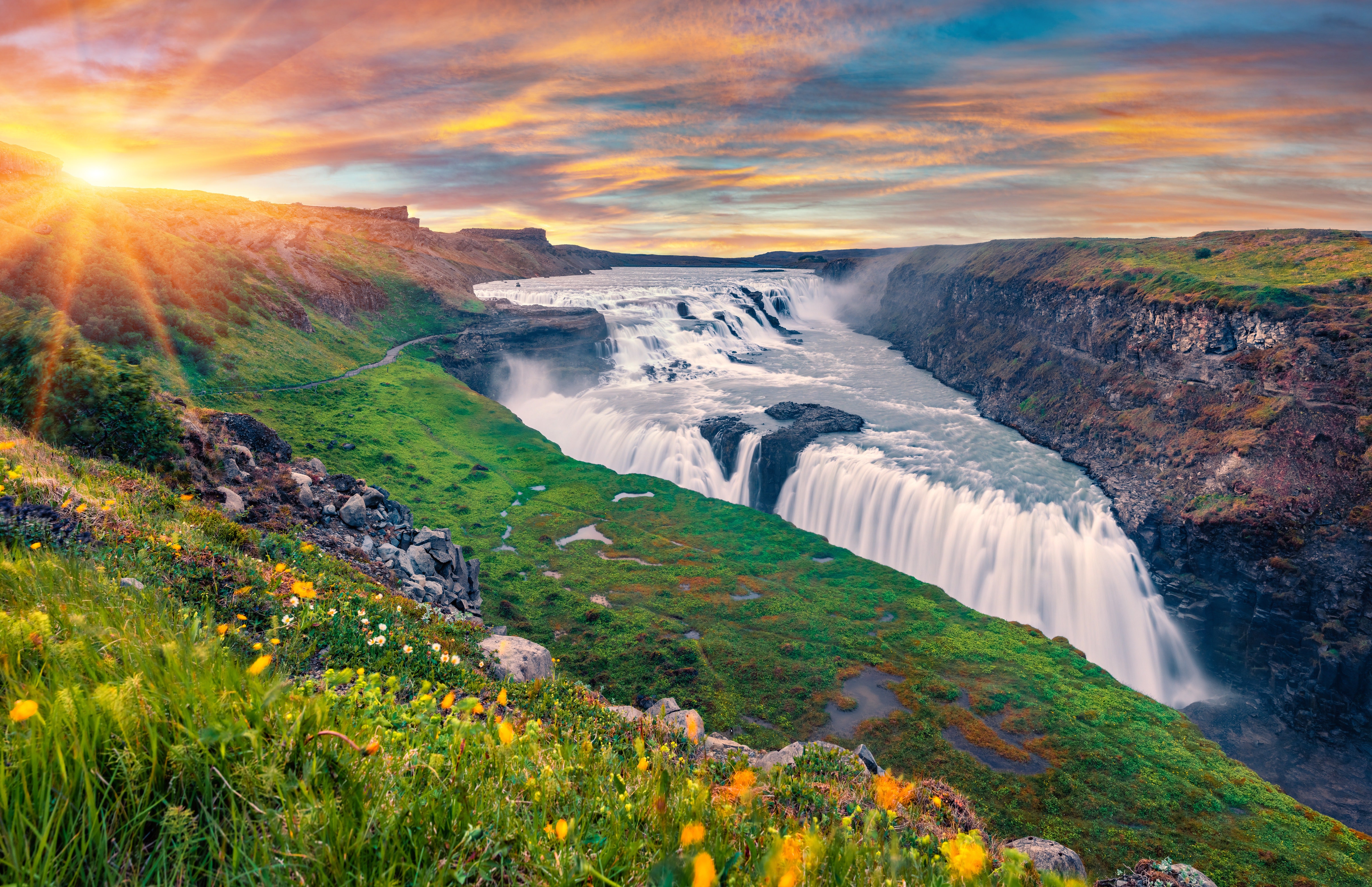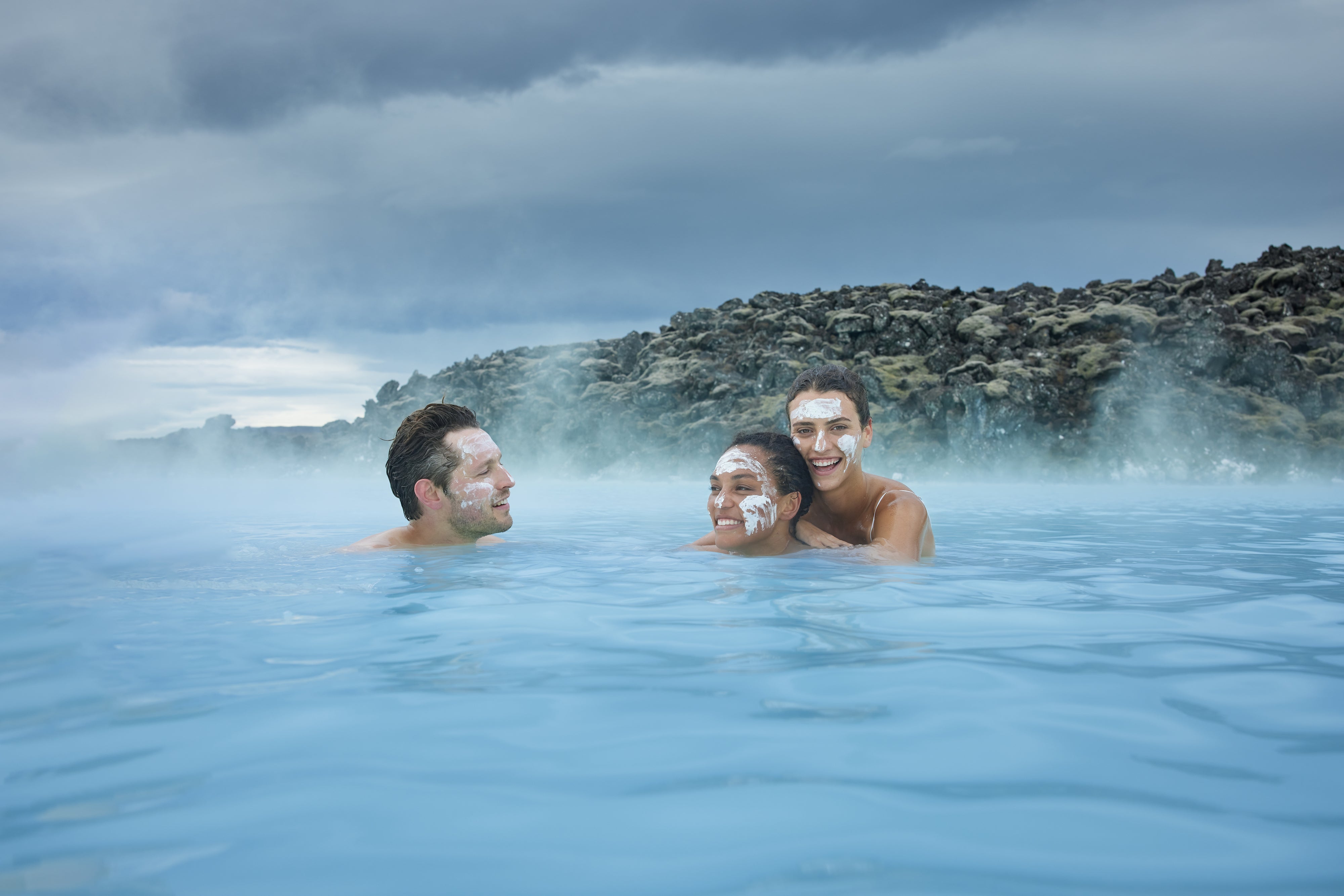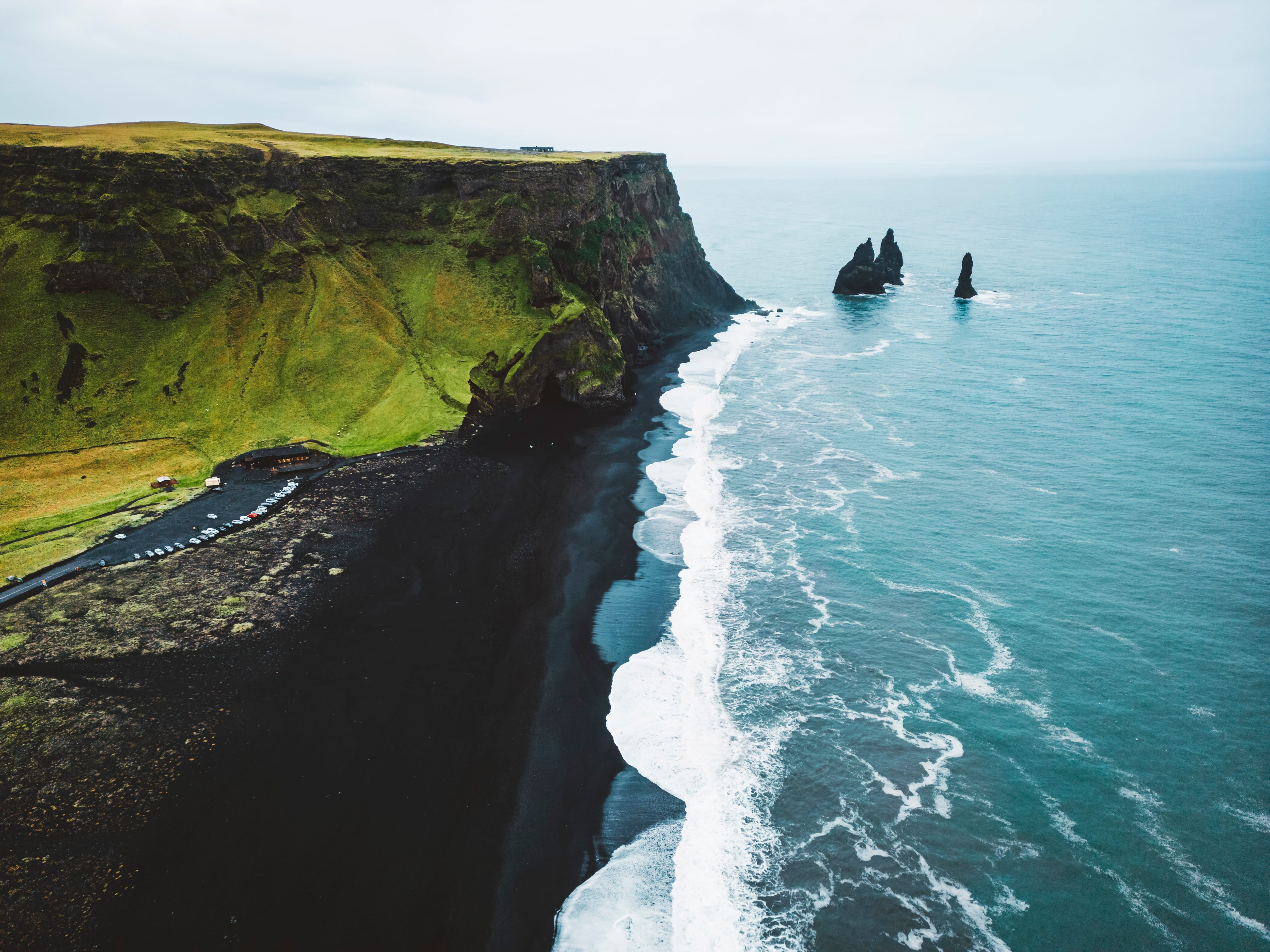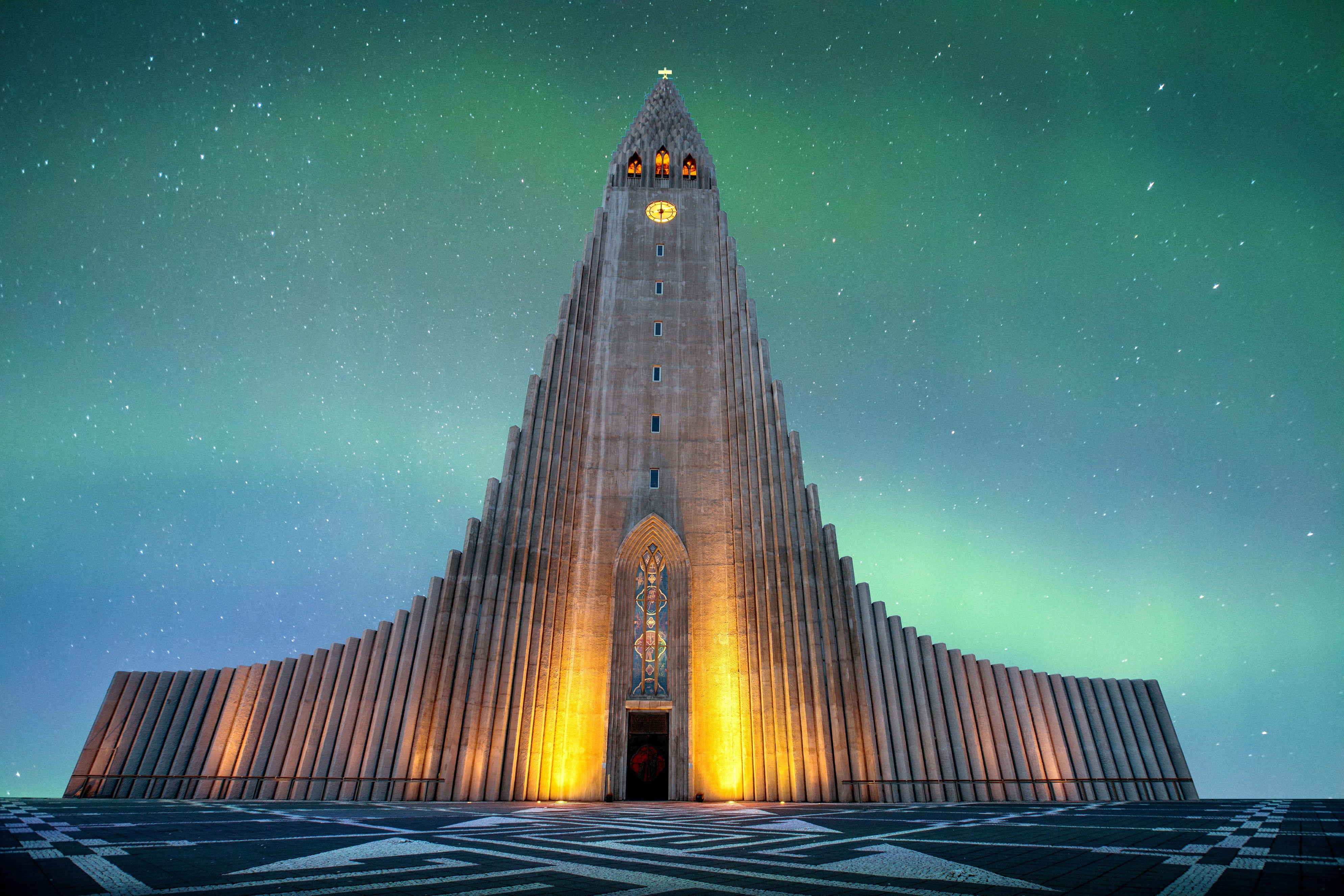
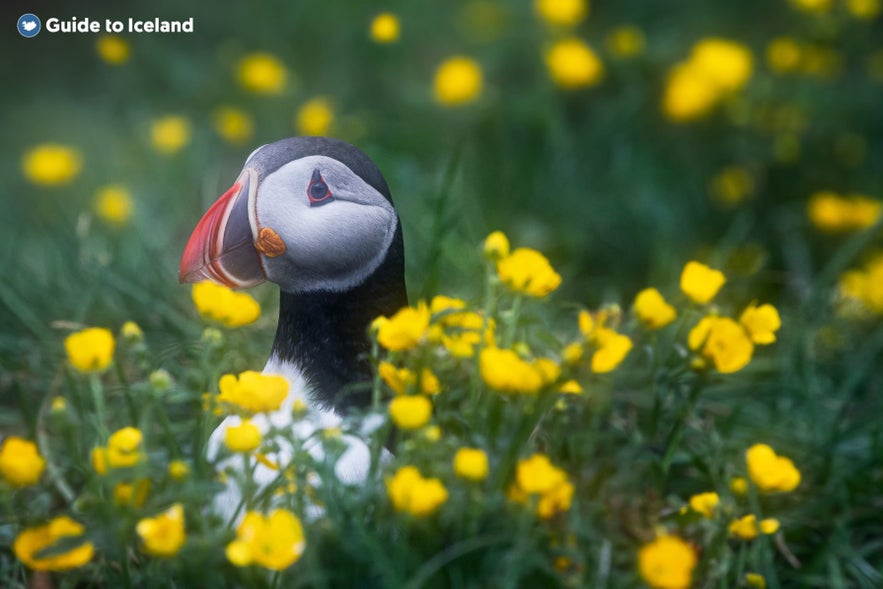
Learn about the most common flowers and herbs you'll find when exploring Iceland. Discover the diverse and resilient world of the Icelandic flora, thriving amidst the island's unique climate and natural wonders.
Iceland is famous for its vast black sands, glaciers, and lava fields, often described as otherworldly. It may come as a surprise, then, that you'll find a diverse and vibrant flora around the country!
Why You Can Trust Our Content
Guide to Iceland is the most trusted travel platform in Iceland, helping millions of visitors each year. All our content is written and reviewed by local experts who are deeply familiar with Iceland. You can count on us for accurate, up-to-date, and trustworthy travel advice.
Despite Iceland's location near the Arctic Circle and its harsh climate, you'll encounter various flowers and herbs when exploring iconic attractions, doing self-drive tours, or hiking in the remote Highlands. Learn about the most common Icelandic flowers and herbs you'll see on your journey, their cultural significance, and their historical uses.
Most of these common Icelandic plants can be found around the country, so you're likely to spot many of them during your visit, no matter where you've booked your accommodation in Iceland. Whether you're exploring with nature tours or a rental car, you'll gain a new appreciation for the landscapes of this stunning island.
Key Takeaways
-
Diverse Flora: Iceland’s harsh climate still supports hardy wildflowers, mosses, and herbs.
-
National Symbol: The Mountain Avens (Holtasóley), the national flower of Iceland, is valued for soil stability and folklore.
-
Notable Plants:
-
Nootka lupine is a striking flower, but it is also invasive.
-
Sea campion, forget-me-not, harebell, and others have medicinal or edible uses.
-
-
Herbal Traditions: Plants like Icelandic Arctic thyme are used in cooking and remedies.
-
Environmental Insight: Lupine spread highlights the balance between restoration and native biodiversity.
- For more on all Icelandic plants: Plants in Iceland | Flora Under the Arctic Circle
What to Know About Iceland's Flora
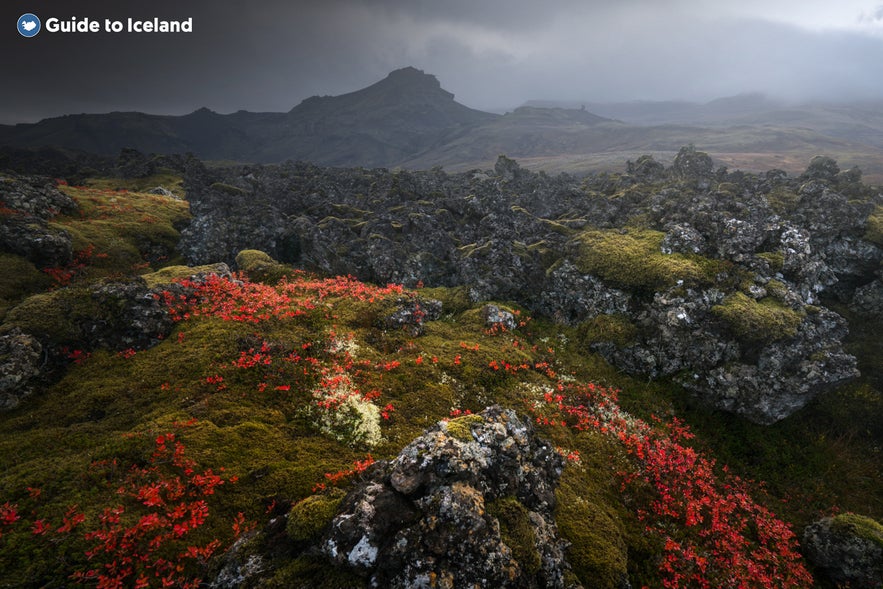
The history of Iceland's vegetation is closely linked to its harsh climate and volcanic landscape. Originally, birch forests and rich flora covered much of the island, but widespread deforestation occurred with the arrival of settlers in the Viking Age.
This led to severe soil erosion, made worse by Iceland's harsh weather conditions, including strong winds and volcanic activity. This has led to significant loss of topsoil and vegetation cover over centuries, meaning the Icelandic landscape can be quite delicate and fragile.
The climate and difficult soil have hindered the growth of many plants. Nevertheless, Iceland is home to resilient native flowers, herbs, and other plants that have adapted to the challenging conditions!
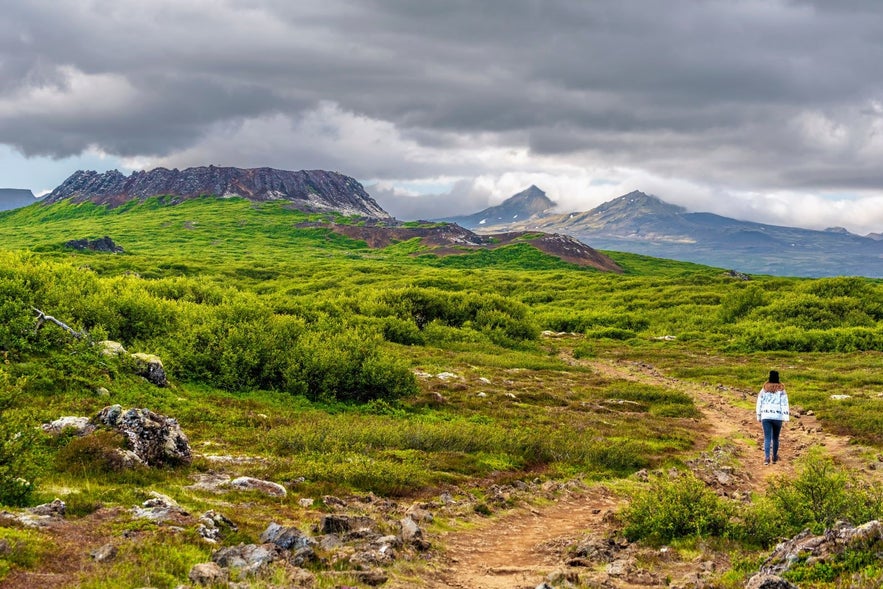
If you want to experience the properties of the Icelandic flora for yourself, you should always leave the wild nature untouched and just as you found it! Instead, you can find Icelandic products in stores around Reykjavik that use herbs in an environmentally friendly way.
It's the best way to add a piece of Iceland into your daily life.
- Learn more about the Forests of Iceland: Foresting a Treeless Land
National Flower of Iceland - Mountain Avens
 The Mountain Avens (Dryas octopetala), or "Holtasóley" in Icelandic, deserves a special highlight as it's the national flower of Iceland! As the name indicates, Mountain Avens love mountainous regions, but they can be found all over Iceland's rugged landscapes.
The Mountain Avens (Dryas octopetala), or "Holtasóley" in Icelandic, deserves a special highlight as it's the national flower of Iceland! As the name indicates, Mountain Avens love mountainous regions, but they can be found all over Iceland's rugged landscapes.
The Mountain Avens flower features delicate white petals and a yellow center. Its dark green leaves are an essential food source for rock ptarmigans, and they're even called "rjúpnalauf" or "ptarmigan leaves" in Icelandic!
It's an important flower for soil stabilization, and Mountain Avens are also surrounded by folklore. Its root was believed to bring wealth if used correctly, so it historically had the nickname "þjófarót" or thief's root!
- Learn more about the Wildlife and Animals in Iceland
Most Common Flowers in Iceland
The Icelandic nature features a great variety of flowers, adding color to the dramatic landscape. Here are some of the most common flowers you'll encounter as you explore Iceland!
Nootka Lupine in Iceland
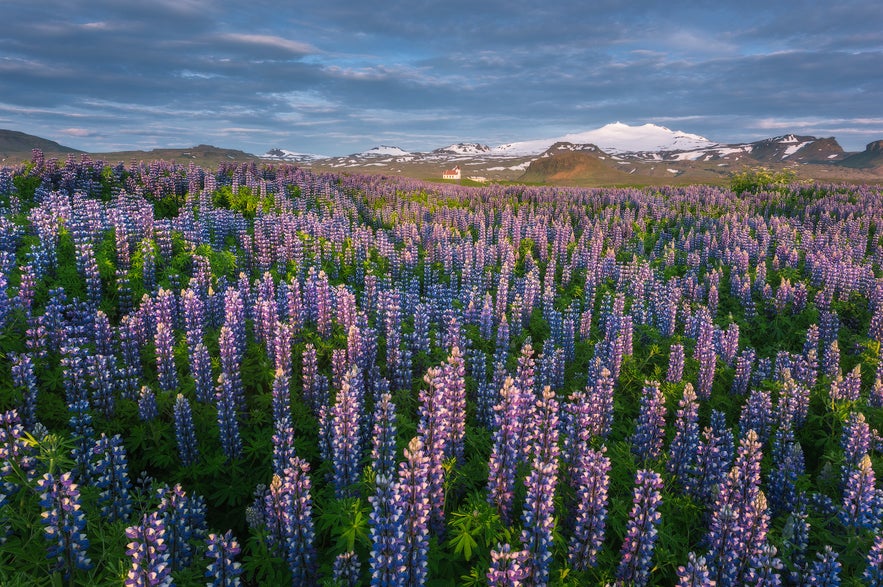 If you ever hear anyone mention the "blue flowers in Iceland," you can be pretty sure they're talking about the Nootka Lupine (Lupinus nootkatensis). It drapes Iceland's mountainsides and vast black sands in summer and grows up to 23 inches tall (60 centimeters).
If you ever hear anyone mention the "blue flowers in Iceland," you can be pretty sure they're talking about the Nootka Lupine (Lupinus nootkatensis). It drapes Iceland's mountainsides and vast black sands in summer and grows up to 23 inches tall (60 centimeters).
The controversial Lupine is not native to Iceland but was introduced in the 1940s to help with soil erosion. Since then, it has spread like a weed all around Iceland and has proven difficult to control. Depending on who you ask, they're either a welcome addition of color to the Icelandic landscape or an absolute menace!
Nonetheless, Lupine fields can be quite stunning and are popular among photographers. You'll see them if you plan to explore the Snaefellsjokull National Park, as the photo above showcases, or when exploring the South Coast. They're truly impossible to miss when visiting Iceland in summer!
- See also: National Parks in Iceland
Sea Campion in Iceland
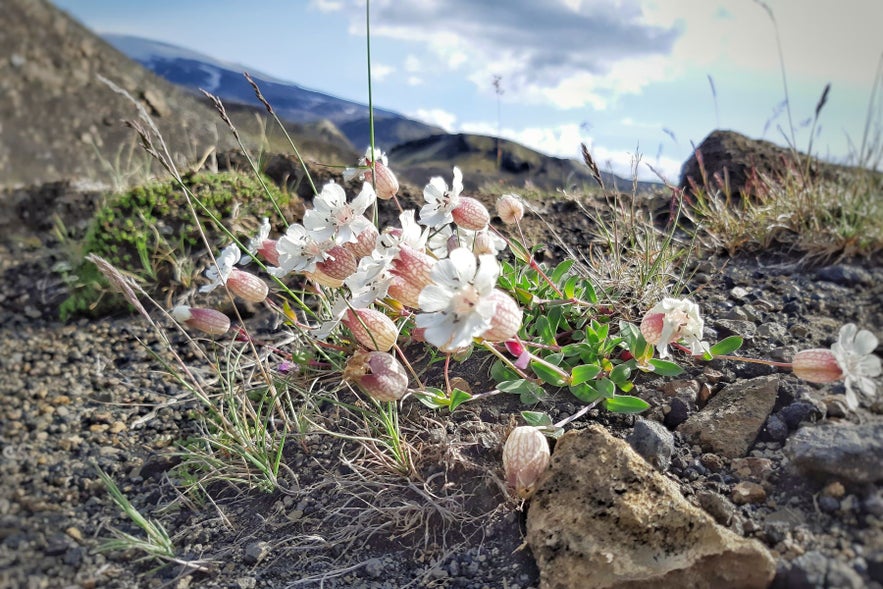
The Sea Campion (Silene uniflora), known in Icelandic as "Holurt," is a fascinating flower that thrives in sandy, gravelly, and rocky soils. It can be found along seashores in many countries, but it uniquely grows more inland in Iceland because of the terrain.
Sea Campions are hardy and showcase delicate white flowers when they bloom in summer. Its appearance is distinct, so you'll easily recognize it if you come across it during your Iceland adventure!
This flower is sometimes called fly flower or "flugnablóm" by Icelanders, but this is likely because you can sometimes see flies stuck inside. It has medicinal uses, as it has historically been used to treat cough and physical pain. It's even said to be able to clear out retained placenta!
You'll likely encounter the Sea Campion when exploring the vast sands and beaches of the South Coast, like with this black sand beach horseriding tour from Vik, but it can be seen around most of Iceland.
Icelandic Forget-Me-Not

The delicate Forget-me-not flower (Myosotis arvensis) is also known by the name Scorpion grass and is called "Gleym-mér-ei" in Icelandic. You can find them in most regions of the country, except for a part of Northeast Iceland and the Highlands.
The Forget-me-not flowers are said to have healing properties as they can be applied to minor burns and wounds and help with swelling. They're most famous, however, for their ability to stick to fabric, thanks to their hairy stem, and have likely spread around Iceland by sticking to sheep's wool!
It's also common for hikers to stick a Forget-me-not to their sweater when they come across these flowers, though we always encourage leaving nature untouched.
Harebell in Iceland
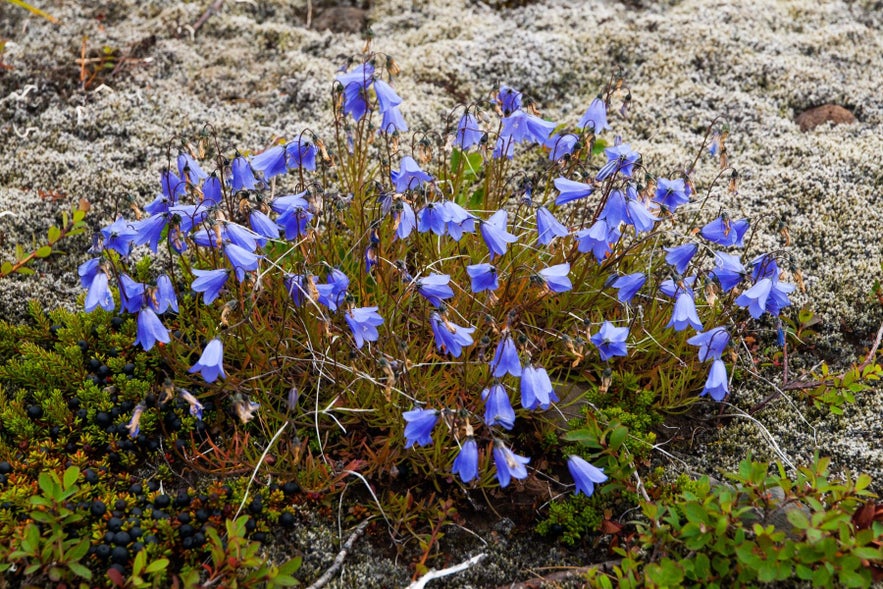
If you're traveling around Iceland's eastern region, you may spot the beautiful violet colors of the Harebell flower (Campanula rotundifolia). It's known as "Bláklukka" or bluebell in Icelandic, and it blooms between July and August.
Harebell grows wild around the Eastfjords but is rarely found in other regions! You can spot it at the Skaftafell Nature Reserve if you hike up to the Skaftafellsjokull Glacier, so keep an eye out if you plan to do glacier hiking in the area.
Iceland Moss Campion
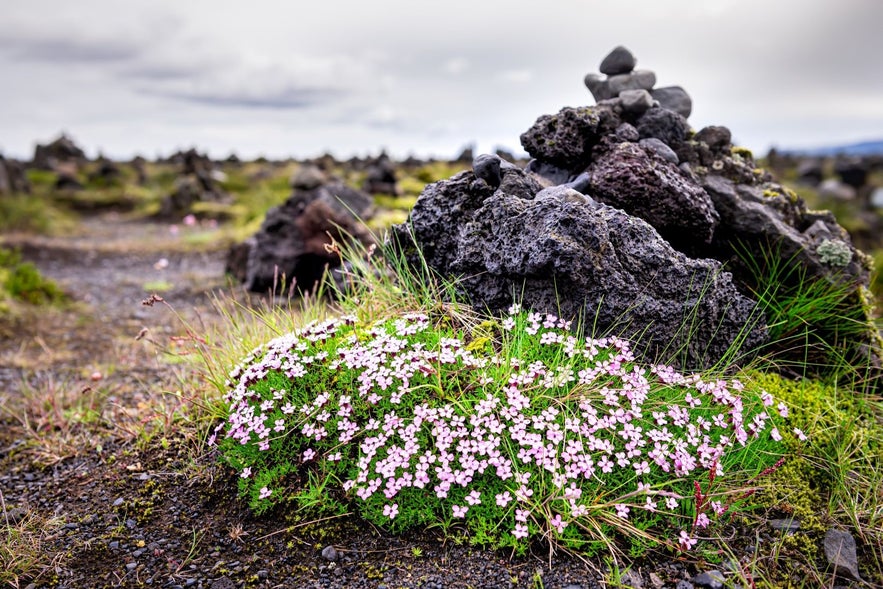
Moss Campion (Silene acaulis) is known as "Lambagras" in Icelandic, which translates to "lamb grass." It's one of the most common flowers you'll encounter while hiking in Iceland.
This hardy plant forms cushion-like, dense mounds that help protect it from the harsh, cold winds and make it appear moss-like. Moss Campion is adorned with small, bright pink to purple flowers, and historically, its root was eaten when food was scarce. People would boil the root to soften it, but it can also be fried in a pan with butter.
Iceland Sea Thrift
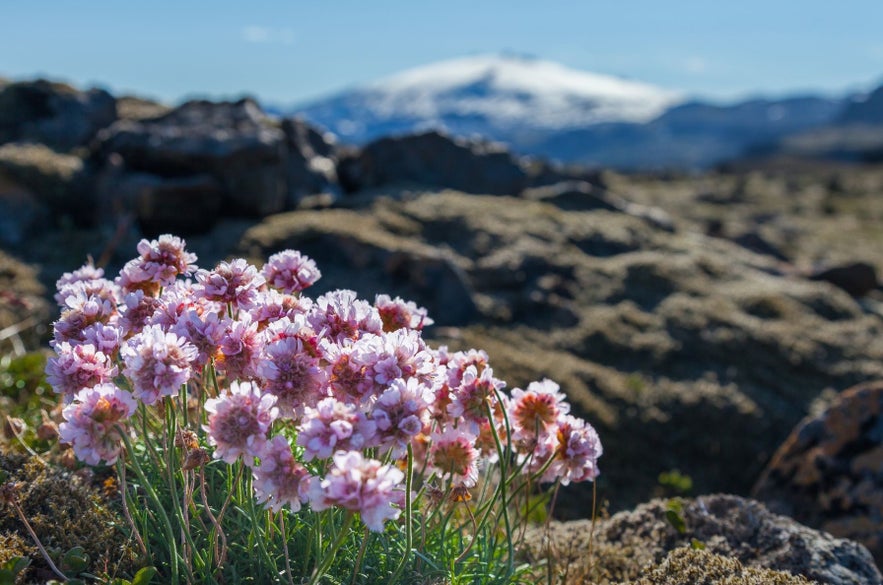
Sea Trifts (Armeria maritima thrift) are hardy plants that form dense, cushion-like tufts of narrow, grass-like leaves. When they bloom, they produce round, pink flower heads on tall, slender stalks.
These flowers are known as "Geldingahnappur" in Icelandic and are very common all over the country.
They're especially well-adapted to the harsh conditions of salty, windy coastal areas and thrive in poor, dry soils, making them an important plant for stabilizing soil in Iceland.
Like Moss Campion root, these flowers were historically eaten when people lacked food, and they're not known to have any medicinal uses. They are, however, some of the more beautiful flowers you'll encounter in the Icelandic wilderness.
Icelandic Wood Crane's Bill
 The Wood Crane's Bill flower (Geranium sylvaticum) is native to Iceland and can be found in many parts of Europe. The Icelandic name for the flower is "Blágresi," which translates to bluegrass. This is likely because it's often found in grassy fields or those rare Icelandic forests!
The Wood Crane's Bill flower (Geranium sylvaticum) is native to Iceland and can be found in many parts of Europe. The Icelandic name for the flower is "Blágresi," which translates to bluegrass. This is likely because it's often found in grassy fields or those rare Icelandic forests!
The Wood Crane's Bill is known for its tall and thin stem and small blue petals that add a splash of color to the green Icelandic meadows. The plant can grow up to 23 inches (60 centimeters) in height.
Like many other Icelandic flowers, it's said to harbor medicinal properties. The Wood Crane's Bill has traditionally been used in herbal medicine to treat minor wounds and diarrhea. Its green leaves have also been used to dye fabric black and blue!
Most Common Herbs in Iceland
During your travels, you may encounter some of the lovely herbs native to Iceland. Many have been a staple in Icelandic cuisine, and some are even still used today!
Icelandic Arctic Thyme

Arctic Thyme (Thymus praecox) is a hardy herb native to Iceland, known for its aromatic foliage and delicate purple flowers. It's called "Blóðberg" in Icelandic, and you can find it all over Iceland, especially in mossy areas.
You'll likely come across it during the summer while traveling the Ring Road, as its vibrant color is easy to spot!
The Arctic Thyme has been used in herbal remedies for centuries due to its purported medicinal properties. It's supposedly good for colds, flu, and digestive issues, and can help with sleep problems.
This plant is closely related to Thymian, which you'll likely find in your kitchen drawer! Like its cousin, the Arctic Thyme is a popular herb for its distinct flavor and lovely scent.
It pairs nicely with Icelandic lamb, and you may encounter this ingredient when visiting local restaurants or during this Reykjavik food walk tour. The Arctic Thyme has also traditionally been used for herbal tea, known in Icelandic as "Blóðbergste," or in combination with other wild herbs.
Iceland Sheep Sorrel
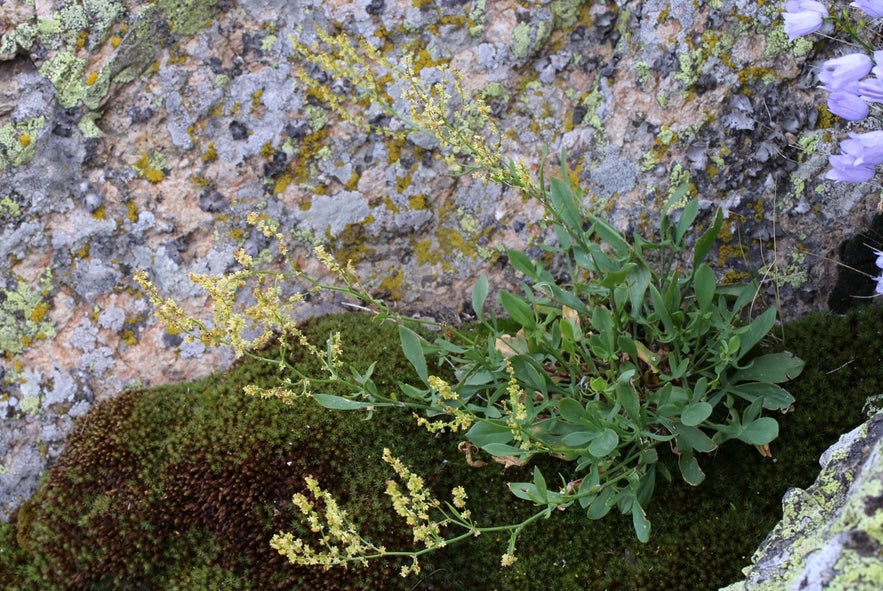
Sheep Sorrel (Rumex acetosella), known in Icelandic as Hundasúra, is an herb recognized for its distinctive sour-tasting leaves. Sheep sorrel has been traditionally used in soups for its distinct flavor, and most Icelanders have likely tasted it in the wild at some point, especially in childhood.
The Sheep Sorrel plant has a lot of variety; its flowers are usually red but can also appear light green. The plant is often found in open, disturbed areas like grasslands and roadsides.
Icelandic Yarrow
 One of Iceland's most significant medicinal plants is the Yarrow (Achillea millefolium). It's known as "Vallhumall" in Icelandic and is most common in North, Northeast, and Southwest Iceland. It can grow up to 16 inches tall (40 centimeters) and blooms small white flowers, forming clusters. It also has a strong scent.
One of Iceland's most significant medicinal plants is the Yarrow (Achillea millefolium). It's known as "Vallhumall" in Icelandic and is most common in North, Northeast, and Southwest Iceland. It can grow up to 16 inches tall (40 centimeters) and blooms small white flowers, forming clusters. It also has a strong scent.
Yarrow has been used for medicine worldwide, and the earliest mentions of its use in Iceland trace back to the 14th century!
It has been used to help heal external and internal wounds, treat skin conditions like eczema, treat colds and flu, and provide tooth pain relief.
It's supposedly good for lowering blood pressure, regulating menstruation, and helping with the side effects of menopause. Today, it's also a popular ingredient in Icelandic skin care products!
Icelandic Angelica

The tall Angelica herb (Angelica archangelica) is a common sight among the Icelandic flora. It thrives in the moist, nutrient-rich soil along rivers, meadows, and other damp environments across Iceland. In Icelandic, it is known as "Ætihvönn."
Angelica has an important place in Icelandic history. It was valued for its medicinal properties and as a food source. It's still used in herbal products today!
This herb can grow up to 6 and a half feet tall (2 meters), displaying large, umbrella-like clusters of greenish-white flowers. Its leaves are large and serrated, and the stems are thick and hollow. Its growth can be hard to control, and it can form vast fields in the wild. It can even make its way to urban gardens, to the great dismay of locals, as it's difficult to get rid of!
Be aware that Angelica can be confused with similar-looking plants like Persian Hogweed (Heracleum persicum) and Giant Hogweed (Heracleum mantegazzianum). They're both toxic and should not be touched, but thankfully, they're not as common as the Angelica.
Best Places to See Icelandic Flowers and Herbs
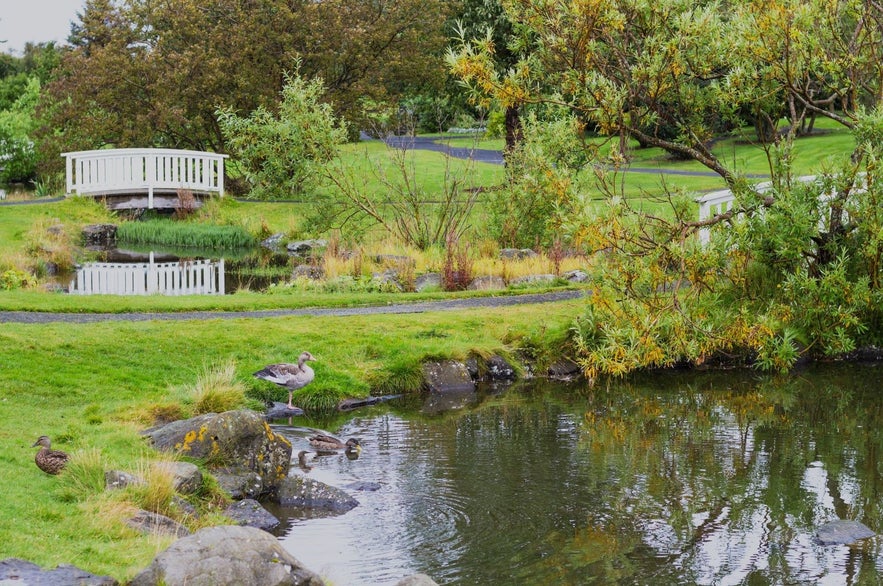 When exploring Icelandic nature in summer, you'll come across many wildflowers, herbs, and other plants native to the stunning landscapes. However, if you want to see all that the Icelandic flora offers, it's best to visit some of Iceland's botanical gardens!
When exploring Icelandic nature in summer, you'll come across many wildflowers, herbs, and other plants native to the stunning landscapes. However, if you want to see all that the Icelandic flora offers, it's best to visit some of Iceland's botanical gardens!
If you're considering a stay in hotels in Reykjavik, you can spend an afternoon visiting the Reykjavik Botanical Garden in the historic Laugardalur Valley. It's just a 12-minute drive from the city center with a small rental car.
You can observe the beautiful plants and stroll along the park's picturesque pond. While there, we recommend visiting the park's café, Flóran, where you can enjoy a coffee or a meal among the flora. You can also use the opportunity to visit the nearby Reykjavik Family Park & Zoo.
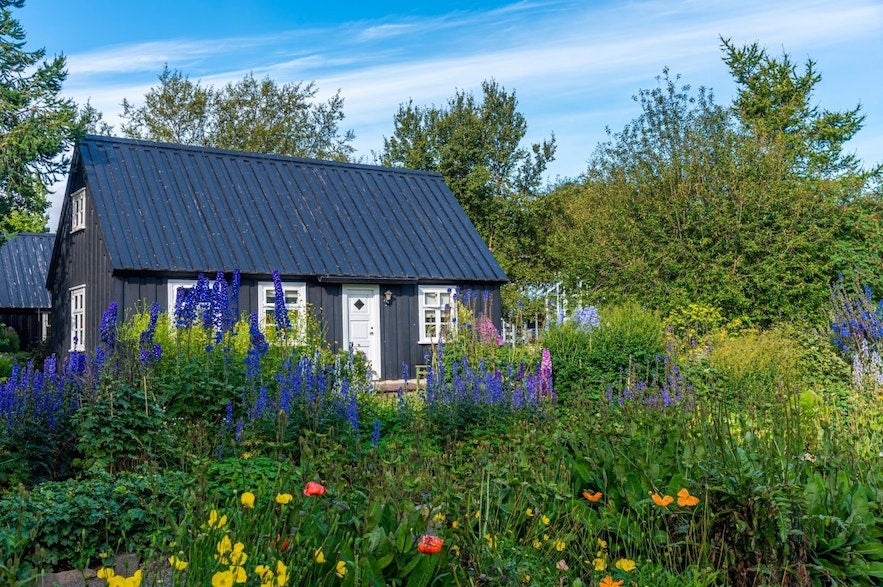 You're in for a special treat if you're visiting North Iceland. In Akureyri, the region's largest town, you'll find the beautiful Akureyri Botanical Gardens.
You're in for a special treat if you're visiting North Iceland. In Akureyri, the region's largest town, you'll find the beautiful Akureyri Botanical Gardens.
It opened in 1912 and has plants from all over the world, but you won't want to miss the park's special section dedicated to plants native to Iceland, including those mentioned here!
Next to the "Flora of Iceland" section, you'll find the park's charming LYST, where you can enjoy a delicious lunch. Make sure to include a stop if you're visiting the region, as the Akureyri Botanical Garden is truly one of the more beautiful urban spaces in Iceland.
Summary of Icelandic Flowers and Herbs
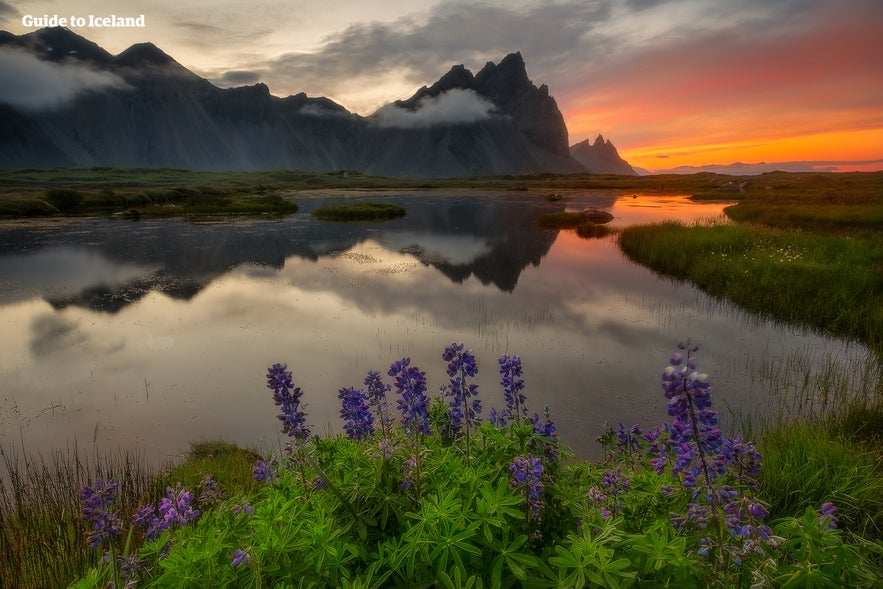 Iceland's diverse flowers and herbs are deeply entwined with the country's culture and history. They add color to the dramatic landscapes, help with soil erosion, and have served as medicine and food for Icelanders through the centuries.
Iceland's diverse flowers and herbs are deeply entwined with the country's culture and history. They add color to the dramatic landscapes, help with soil erosion, and have served as medicine and food for Icelanders through the centuries.
Whether you're planning to visit iconic attractions, stay within the Capital Region, or hike through remote landscapes, getting to know the native flora of Iceland will provide a new appreciation for the country's unique nature!
Keep an eye out for these common flowers and herbs during a visit to Iceland, and consider trying out traditional food, teas, skincare, and other products that celebrate the benefits of these plants.
Would you look for these flowers and herbs during a visit to Iceland? Which one of these is your favorite? Have you tried any products made from Icelandic plants? Share your thoughts and experience in the comments below!


